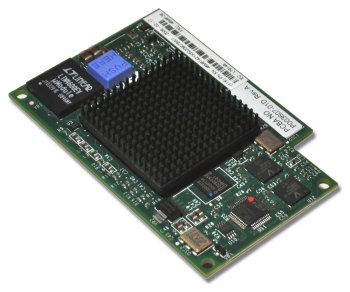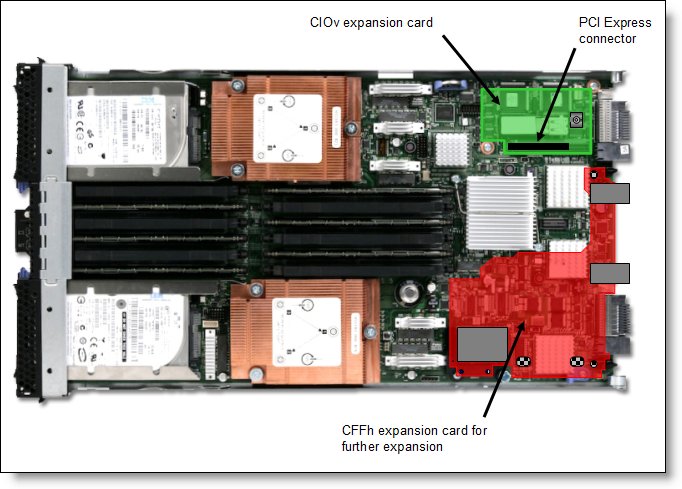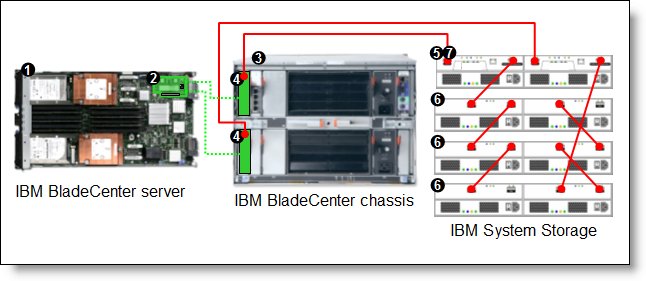Abstract
The Emulex 8Gb Fibre Channel Expansion Card (CIOv) for IBM BladeCenter enables high-performance connection to a storage area network (SAN). Thanks to the innovative design of the IBM BladeCenter midplane, this Fibre Channel adapter operates without needing an optical transceiver module, saving you significant hardware costs. Each adapter provides dual paths to the SAN switches to ensure full redundancy. Meanwhile the exclusive firmware-based architecture allows firmware and features to be upgraded without taking the server offline or rebooting and without needing to upgrade the driver.
Note: This adapter is withdrawn from marketing.
Introduction
The Emulex 8Gb Fibre Channel Expansion Card (CIOv) for IBM BladeCenter enables high-performance connection to a storage area network (SAN). Thanks to the innovative design of the IBM BladeCenter midplane, this Fibre Channel adapter operates without needing an optical transceiver module, saving you significant hardware costs. Each adapter provides dual paths to the SAN switches to ensure full redundancy. Meanwhile the exclusive firmware-based architecture allows firmware and features to be upgraded without taking the server offline or rebooting and without needing to upgrade the driver.
Figure 1 shows the Emulex 8Gb Fibre Channel Expansion Card (CIOv).
Figure 1. Emulex 8Gb Fibre Channel Expansion Card (CIOv)
Did you know?
When using the CIOv adapter, you can simultaneously use a CFFh adapter to enable more types of I/O to supported blade servers such as the HS22 when installed in the IBM BladeCenter H chassis. The innovative design of the CIOv adapter works with the CFFh adapter to support this combination.
This expansion card connects directly to the midplane without having to use cables or optical modules. By eliminating these components for up to 14 servers, the resulting savings alone covers the BladeCenter chassis investment.
You can upgrade the firmware of Emulex host bus adapters (HBAs) without taking the server offline or rebooting. This is an exclusive Emulex feature that minimizes downtime and protects the investment in your infrastructure.
Part number information
Table 1 shows the part number to order this card.
Table 1. Part number and feature code for ordering
| Description | Part number | Feature code* |
| Emulex 8Gb Fibre Channel Expansion Card (CIOv) for IBM BladeCenter | 46M6140 | 3598 / 8240 |
* The first feature code listed is for configurations available through the System x sales channel. The second feature code listed is for configurations available through the Power Systems sales channel
This part number includes the following items:
- One Emulex 8Gb Fibre Channel Expansion Card (CIOv) for IBM BladeCenter
- Documentation CD that contains the Emulex 8Gb Fibre Channel Expansion Card (CIOv) for IBM BladeCenter Installation and User’s Guide
- Important Notices document
Features
The expansion card has the following features and benefits:
- Support of the 8 Gbps Fibre Channel standard
- Use of the Emulex "Saturn" 8Gb Fibre Channel I/O Controller (IOC) chip
- Enablement of high-speed and dual-port connection to a Fibre Channel SAN
- Can be combined with a CFFh card on the same blade server
- Comprehensive virtualization capabilities with support for N_Port ID Virtualization (NPIV) and Virtual Fabric
- Simplified installation and configuration using common HBA drivers
- Efficient administration by using HBAnyware for HBAs anywhere in the SAN
- Common driver model that eases management and enables upgrades independent of HBA firmware
- Support of BladeCenter Open Fabric Manager
- Support for NPIV when installed in the JS23/JS43
IBM BladeCenter leads the industry in delivering integrated fabric switching to the blade server environment. Integrated fabric switching eases deployment, simplifies the data center, reduces cabling and optical transceivers (SFPs), and lowers costs. BladeCenter clients have the flexibility to choose from a variety of SAN switch vendor's architectures.
Each BladeCenter server provides redundant connections to data and storage networks. You can configure your blade servers with dual port host bus adapters and be assured that you will always have a connection to your SAN by using BladeCenter's high availability midplane. Through integration, BladeCenter eliminates the fiber-optic cables from the server to the switch. This reduces the opportunity for misconfiguration and lowers the expense for cables and optical transceivers. It also reduces potential points of failure, while increasing network availability.
Specifications
The expansion card has the following specifications:
- Fibre Channel specifications:
- Bandwidth: Burst transfer rate of up to 1600 MBps full-duplex per port
- Support for point-to-point fabric connection: F-Port Fabric Login
- Support for Fibre Channel Arbitrated Loop (FC-AL) and FCAL-2 FL-Port Login
- Support for Fibre Channel services class 2 and 3
- Single-chip design with two independent 8 Gbps serial Fibre Channel ports, each of which provides:
- Reduced instruction set computer (RISC) processor
- Integrated serializer/deserializer
- Receive direct memory access (DMA) sequencer
- Frame buffer
- Onboard DMA: DMA controller for each port: Transmit and receive
- Frame buffer first in, first out (FIFO): Integrated transmit and receive frame buffer for each data channel
- Internal memory:
- 1.5 MB internal high-speed SRAM, ECC protected
- 4 MB non-volatile RAM (NVRAM), 2 MB per port
Operating environment
The expansion card is supported in the following environment:
- Temperature: 10 to 52°C (50 to 126°F) operating (requires airflow of 50-150 linear feet per minute)
- Relative humidity: 5% to 95% non-condensing
Supported servers and I/O modules
This card is installed in the PCI Express CIOv slot of a supported blade server. It provides 8 Gbps connections to Fibre Channel-compatible modules in bays 3 and 4 of supported BladeCenter chassis. A maximum of one CIOv expansion is supported per single-wide (30 mm) blade server. Table 2 lists the IBM BladeCenter servers that support the Emulex 8Gb Fibre Channel Expansion Card (CIOv).
Table 2. Supported servers
Emulex 8Gb FC Expansion Card (CIOv) |
N |
N |
N |
N |
Y |
Y |
Y |
Y |
Y |
N |
N |
N |
Y |
Y |
Y |
See IBM ServerProven at the following address for the latest information about the expansion cards supported by each blade server type:
http://ibm.com/servers/eserver/serverproven/compat/us/
CIOv expansion cards are installed in the CIOv slot in supported servers as shown in Figure 2.
Figure 2. Location of the CIOv slot in the IBM BladeCenter HS22
The Emulex 8Gb Fibre Channel Expansion Card (CIOv) requires that a supported I/O module is installed in bay 3 and bay 4 of the chassis in which the cards and servers are installed.
Table 3 lists the supported I/O modules that can be used to connect to the expansion card. The 8 Gb switch modules are recommended. The card also supports 4 Gb Fibre Channel switch modules and the 4 Gb Intelligent Pass-thru Module. However, the card must operate at the 4 Gbps rate.
Table 3. Compatibility information for I/O modules and the Emulex 8Gb Fibre Channel Expansion Card (CIOv)
Supported I/O modules (operate at 8 Gbps) |
||||||
Brocade Enterprise 20-port 8Gb SAN Switch |
42C1828 |
N |
Y |
Y |
N |
Y§ |
Brocade 20-port 8Gb SAN Switch Module |
44X1920 |
N |
Y |
Y |
N |
Y§ |
Brocade 10-port 8Gb SAN Switch Module |
44X1921 |
N |
Y |
Y |
N |
Y§ |
QLogic 20-port 8Gb SAN Switch Module |
44X1905 |
Y |
Y |
Y |
Y* |
Y§ |
QLogic 8Gb Intelligent Pass-thru Module |
44X1907 |
Y |
Y |
Y |
Y* |
Y§ |
QLogic 20-Port 4/8Gb SAN Switch Module |
88Y6406 |
Y |
Y |
Y |
Y* |
Y§ |
QLogic 4/8Gb Intelligent Pass-thru Module |
88Y6410 |
Y |
Y |
Y |
Y* |
Y§ |
Supported I/O modules (operate at 4 Gbps) |
||||||
Brocade 4 Gb 20-Port SAN Switch Module |
32R1812 |
N |
N |
N |
N |
N |
Brocade 4 Gb 10-Port SAN Switch Module |
32R1813 |
N |
N |
N |
N |
N |
Cisco 4 Gb 20-Port Fibre Channel Switch Module |
39Y9280 |
N |
Y |
Y |
Y* |
Y |
Cisco 4 Gb 10-Port Fibre Channel Switch Module |
39Y9284 |
Y |
Y |
Y |
Y* |
Y |
QLogic 20-Port 4 Gb SAN Switch Module |
43W6725 |
N |
Y |
Y |
Y* |
Y |
QLogic 10-Port 4 Gb SAN Switch Module |
43W6724 |
Y |
Y |
Y |
Y* |
Y |
QLogic 4 Gb Intelligent Pass-thru Module |
43W6723 |
Y |
Y |
Y |
Y* |
Y |
Take into account the following restrictions regarding the use of switch modules listed in Table 3:
- The IBM BladeCenter Optical Pass-thru Module, 39Y9316, is not supported
- (*) When any of the switch modules indicated with (*) is installed in BladeCenter T, the internal switch connections to blade ports operate at 2 Gbps. The external ports operate at up to 8 Gbps (or 4 Gbps for 4 Gb switch modules).
- (§) When any of these switch modules that have the section indicator symbol (§) is installed in BladeCenter HT, the internal switch connections to blade ports are supported at 4 Gbps. The external ports operate at up to 8 Gbps (or 4 Gbps for 4 Gb switch modules).
- The Emulex 8Gb Fibre Channel Expansion Card (CIOv) can be installed in servers in the BladeCenter S and are used with supported switch modules as shown in the table. However, by doing so, you lose the ability to connect to the BladeCenter S Disk Storage Modules (DSMs). The Fibre Channel expansion card goes in the place of the SAS expansion card that is needed to connect to the DSMs.
Popular configurations
The Emulex 8Gb Fibre Channel Expansion Card (CIOv) can be used in various configurations. Figure 3 shows the CIOv card installed in a supported blade server, which in turn is installed in a BladeCenter chassis. The chassis is connected to the IBM System Storage DS3400. The RAID functionality is provided by the external storage system.
Figure 3. IBM BladeCenter connected to an external IBM System Storage DS3400 storage solution
Table 4 lists the parts that are used in the configuration shown in Figure 3.
Table 4. Components used when connecting the Emulex 8Gb Fibre Channel Expansion Card (CIOv) to external disk storage (as shown in Figure 3)
| Diagram reference | Part number/machine type | Description | Quantity |
| Varies | Supported server | 1 to 14 | |
| 46M6140 | Emulex 8Gb Fibre Channel Expansion Card (CIOv) | 1 per server | |
| Varies | IBM BladeCenter chassis* (see Table 3) | 1 | |
| 44X1905 | QLogic 20-Port 8Gb SAN Switch Module | 1 or 2 | |
| 1726-41X or 1726-42X | IBM System Storage DS3400 (Single or Dual Controller) | 1 | |
| 1727 | Optional: IBM System Storage EXP3000 (Single or Dual ESM) | 1 to 3 | |
| 39R6536 | DS3000 Partition Expansion License | 1 |
*Note: The expansion card can be installed in servers in the BladeCenter S (8886). However, by doing so, you lose the ability to connect to the BladeCenter S Disk Storage Modules (DSMs). The Fibre Channel expansion card goes in the place of the SAS expansion card that is needed to connect to the DSMs.
This configuration also requires cabling between the chassis and the storage server and between the storage server and expansion units. (The cable part numbers are not listed in Table 4.)
Operating system support
The Emulex 8Gb Fibre Channel Expansion Card (CIOv) supports the following operating systems:
For x86-based blade servers:
- Microsoft Windows Server 2008 HPC Edition
- Microsoft Windows Server 2008 R2
- Microsoft Windows Server 2008, Datacenter x64 Edition
- Microsoft Windows Server 2008, Enterprise x64 Edition
- Microsoft Windows Server 2008, Standard x64 Edition
- Microsoft Windows Server 2008, Web x64 Edition
- Microsoft Windows Server 2012
- Microsoft Windows Small Business Server 2008 Premium Edition
- Microsoft Windows Small Business Server 2008 Standard Edition
- Red Hat Enterprise Linux 5 Server Edition
- Red Hat Enterprise Linux 5 Server x64 Edition
- Red Hat Enterprise Linux 6 Server Edition
- Red Hat Enterprise Linux 6 Server x64 Edition
- SUSE LINUX Enterprise Server 10 for AMD64/EM64T
- SUSE LINUX Enterprise Server 10 for x86
- SUSE LINUX Enterprise Server 10 with Xen for AMD64/EM64T
- SUSE LINUX Enterprise Server 11 for AMD64/EM64T
- SUSE LINUX Enterprise Server 11 for x86
- SUSE LINUX Enterprise Server 11 with Xen for AMD64/EM64T
- VMware ESX 4.1
- VMware ESXi 4.1
- VMware vSphere 5.0 (ESXi)
- VMware vSphere 5.1 (ESXi)
For POWER-based blade servers
- IBM AIX 5L for POWER Version 5.3
- IBM AIX Version 6.1
- IBM i operating system 6.1
- Red Hat Enterprise Linux 4 AS for IBM POWER
- Red Hat Enterprise Linux 5 for IBM POWER
- SUSE LINUX Enterprise Server 10 for IBM POWER
See IBM ServerProven at the following address for the latest information about the specific versions and service packs that are supported:
http://ibm.com/servers/eserver/serverproven/compat/us/
Select the blade server and then select the expansion card to see the supported operating systems.
Related product families
Product families related to this document are the following:
Trademarks
Lenovo and the Lenovo logo are trademarks or registered trademarks of Lenovo in the United States, other countries, or both. A current list of Lenovo trademarks is available on the Web at https://www.lenovo.com/us/en/legal/copytrade/.
The following terms are trademarks of Lenovo in the United States, other countries, or both:
Lenovo®
BladeCenter Open Fabric
BladeCenter®
ServerProven®
System x®
The following terms are trademarks of other companies:
Linux® is the trademark of Linus Torvalds in the U.S. and other countries.
Microsoft®, Windows Server®, and Windows® are trademarks of Microsoft Corporation in the United States, other countries, or both.
Other company, product, or service names may be trademarks or service marks of others.
